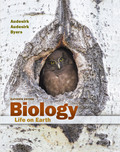
Concept explainers
Whale skeletons contain nonfunctional pelvic bones
a. as a result of convergent evolution.
b. due to catastrophism.
c. because whales evolved from ancestors that had hind legs.
d. because the bones might be needed for a future adaptation.
Introduction:
The vestigial can be referred to a rudimentary structure present in the body of an organism, which does not have any prominent function. These structures were functional in the ancestors of the organism, but during the course of evolution, the organism loses its function.
Answer to Problem 1MC
Correct answer:
The pelvic bone in the whales is a vestigial organ, which had a function in their ancestors, having hind limbs.
Explanation of Solution
Explanation for the correct answer:
Option (c) is given that the nonfunctional pelvic bones are present in whale’s skeleton as whales evolved from the ancestors that had hind legs. The whales are known to evolve from the Pakicetus. These organisms had four legs, and the hind limbs were functional. During the evolution, the hind limbs were lost, but the pelvic bone is still present in the whales. Hence, option (c) is correct.
Explanation for the incorrect answers:
Option (a) is given that the nonfunctional pelvic bones are present in whale’s skeleton as a result of convergent evolution. The convergent evolution can be defined as the process, in which the closely related species independently evolve the similar structures or traits to adapt to the environment. However, the pelvic bones were present in the ancestor of the whales, this is not evolved. So, it is an incorrect option.
Option (b) is that the nonfunctional pelvic bones are present in whale’s skeleton due to catastrophism. The catastrophism referred to a change, which occurs suddenly in the organism. However, the pelvic bones are not suddenly developed in the whales, it is not an example of catastrophism. So, it is an incorrect option.
Option (d) is because that the nonfunctional pelvic bones are present in whale’s skeleton might be needed for a future adaptation. The bones of the pelvis were functional in the ancestors of the whales. This is not evolved for the future adaptation. So, it is an incorrect option.
Hence, options, (a), (b), and (d) are incorrect.
Thus, it can be concluded that pelvic bones are a vestigial organ in whales. These were functional in their ancestors, but in whales, they are nonfunctional.
Want to see more full solutions like this?
Chapter 15 Solutions
EBK BIOLOGY
- 1. Match each vocabulary term to its best descriptor A. affinity B. efficacy C. inert D. mimic E. how drugs move through body F. how drugs bind Kd Bmax Agonist Antagonist Pharmacokinetics Pharmacodynamicsarrow_forward50 mg dose of a drug is given orally to a patient. The bioavailability of the drug is 0.2. What is the volume of distribution of the drug if the plasma concentration is 1 mg/L? Be sure to provide units.arrow_forwardDetermine Kd and Bmax from the following Scatchard plot. Make sure to include units.arrow_forward
- Choose a catecholamine neurotransmitter and describe/draw the components of the synapse important for its signaling including synthesis, packaging into vesicles, receptors, transporters/degradative enzymes. Describe 2 drugs that can act on this system.arrow_forwardThe following figure is from Caterina et al. The capsaicin receptor: a heat activated ion channel in the pain pathway. Nature, 1997. Black boxes indicate capsaicin, white circles indicate resinferatoxin. a) Which has a higher potency? b) Which is has a higher efficacy? c) What is the approximate Kd of capsaicin in uM? (you can round to the nearest power of 10)arrow_forwardWhat is the rate-limiting-step for serotonin synthesis?arrow_forward
 Concepts of BiologyBiologyISBN:9781938168116Author:Samantha Fowler, Rebecca Roush, James WisePublisher:OpenStax College
Concepts of BiologyBiologyISBN:9781938168116Author:Samantha Fowler, Rebecca Roush, James WisePublisher:OpenStax College Biology: The Dynamic Science (MindTap Course List)BiologyISBN:9781305389892Author:Peter J. Russell, Paul E. Hertz, Beverly McMillanPublisher:Cengage Learning
Biology: The Dynamic Science (MindTap Course List)BiologyISBN:9781305389892Author:Peter J. Russell, Paul E. Hertz, Beverly McMillanPublisher:Cengage Learning
 Comprehensive Medical Assisting: Administrative a...NursingISBN:9781305964792Author:Wilburta Q. Lindh, Carol D. Tamparo, Barbara M. Dahl, Julie Morris, Cindy CorreaPublisher:Cengage Learning
Comprehensive Medical Assisting: Administrative a...NursingISBN:9781305964792Author:Wilburta Q. Lindh, Carol D. Tamparo, Barbara M. Dahl, Julie Morris, Cindy CorreaPublisher:Cengage Learning Biology (MindTap Course List)BiologyISBN:9781337392938Author:Eldra Solomon, Charles Martin, Diana W. Martin, Linda R. BergPublisher:Cengage Learning
Biology (MindTap Course List)BiologyISBN:9781337392938Author:Eldra Solomon, Charles Martin, Diana W. Martin, Linda R. BergPublisher:Cengage Learning Human Biology (MindTap Course List)BiologyISBN:9781305112100Author:Cecie Starr, Beverly McMillanPublisher:Cengage Learning
Human Biology (MindTap Course List)BiologyISBN:9781305112100Author:Cecie Starr, Beverly McMillanPublisher:Cengage Learning





